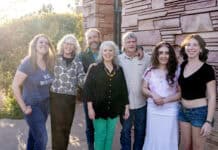After 17 years in Sedona, artist and musician William Faircloth is packing his bags for Hawaii’s Big Island.
Seated in his West Sedona home, where little remains beyond evidence of his shamanic artwork and several pieces of furniture, Faircloth described the creative process behind his art, and ultimately, his decision to leave Sedona after so many years.
Larson Newspapers
After 17 years in Sedona, artist and musician William Faircloth is packing his bags for Hawaii’s Big Island.
Seated in his West Sedona home, where little remains beyond evidence of his shamanic artwork and several pieces of furniture, Faircloth described the creative process behind his art, and ultimately, his decision to leave Sedona after so many years.
As talk of 2012, strange planetary alignments, the conclusion of the Mayan and Hopi calendars and other signs some believe are pointing to extraordinary changes on Earth intensify, Faircloth wonders if humanity is in the midst of a turbulent ascension into the fourth dimension.
“My feeling is that the planet is raising in vibration and so are we,” Faircloth said. “It seems like society is splitting into two groups — those who have a clue as to what is going on and those who are totally blinded …. There used to be a small crack in consciousness, but it’s getting bigger and bigger.”
For some people, change can only mean a doom and gloom scenario involving earthquakes, volcanos, hurricanes and man’s fearful annihilation.
Some of that may ring true, Faircloth said, but ultimately, he envisions a more utopian world, and he’s getting a head start.
On 10 acres of remote jungle land, Faircloth and at least four others will begin new lives totally off the grid.
Using alternative technology, including solar panels for electricity and light emitting diodes for lighting, the group will build new homes and raise their own foods for sustenance.
It’s never cold in Hawaii and it rains every day, so water is plentiful and food is easy to grow, Faircloth said.
He’s an avid camper, and after spending much of his youth in Wales with no running water or electricity, he’s used to living without amenities, he said — though he admits having high-speed Internet access would be nice.
As Faircloth spoke about his plans for the future, an intense horn-headed figure stared from the wall. The figure, bearing many strange Egyptian, African and Tibetan features, is one of Faircloth’s many artistic creations.
Holding a lit lamp, the three-dimensional piece appeared to move through the wall, perhaps illustrating Faircloth’s open mind regarding interdimensional phenomena, as well as his own intuition that his art work may be influenced by possible past life experiences.
Faircloth found his way into an artistic medium which incorporates skulls, bones, beads, turtle shells, animal hair and other organic objects through Sedona author and recycling activist James Bishop Jr.
When Bishop’s mother passed away years ago, she left behind a collection of animal skulls, bits of bones, fabrics and beads, which Faircloth said he picked up and began using to create art.
“Once I started beading skulls, I started seeing things differently,” Faircloth said.
Items like chair bases, table frames and old fabrics seemed to beg for reinterpretation, and Faircloth used them to create inspiring, at times forboding, shamanic figures.
The fact that the bones are real, formed by nature and its enigmatic spirals of DNA, is powerful, Faircloth said. Fake bones and skulls could never carry that same essence.
“It’s not typical gallery stuff,” Faircloth assured. It doesn’t fit in amongst art geared mostly toward tourists.
“It reminds people of a point in time and geography that’s familiar, but that you can’t quite put your finger on,” Faircloth said.
In any case, after nine years of Arizona drought, Faircloth knows exactly where he’s going — where the water is.
